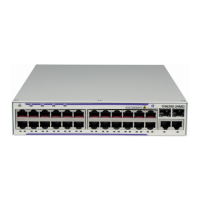Interface Configuration
7210 SAS M, T, X, R6, R12, Mxp Interface Configuration Guide Page 109
CRC Error Monitoring
This feature allows the user to track CRC (cyclic redundancy check) errors received on a given
port and notify them. The detection mechanism is based around a configurable threshold specified
by the administrator. Two thresholds are configurable, one for CRC degrade and one for CRC
signal fail. The first threshold crossing generates an alarm, log entry, trap, but does not bring the
physical port down, while the second (signal fail) threshold crossing logs an alarm, trap
generation, and brings the port operationally down.
The thresholds are configurable with the following CLI command config>port>ethernet crc-
monitor.
Note: This behavior is enabled on a per port basis. By default the command and functionality is
disabled, for the signal degrade and the signal fail.
The user can configure different values for the sf-threshold and the sd-threshold. However, sf-
threshold value must be less than or equal to the sd-threshold value.
The values provided by the user for threshold and multiplier is used to compute the error ratio as
(Multiplier * (10 ^ - (threshold value)). Port Stats are collected once per second and accumulated
over the configured window size. Each second, the oldest sample is discarded and the new sample
is added to a running total. If the error ratio exceeds the configured threshold (as computed above)
over the window size for two consecutive seconds, appropriate actions are taken as follows:
• If the number of CRC errors exceeds the signal degrade threshold value, a log warning
message, syslog event and SNMP trap with the message “CRC errors in excess of the
configured degrade threshold <M>*10e-<N> Set" is raised.
• If the CRC error rate increases further and exceeds configured the signal fail threshold
value, an alarm log message, syslog event and SNMP trap should be raised, and the port
should be brought operationally down.
When the condition is cleared, a SNMP trap message to clear the event is sent out.

